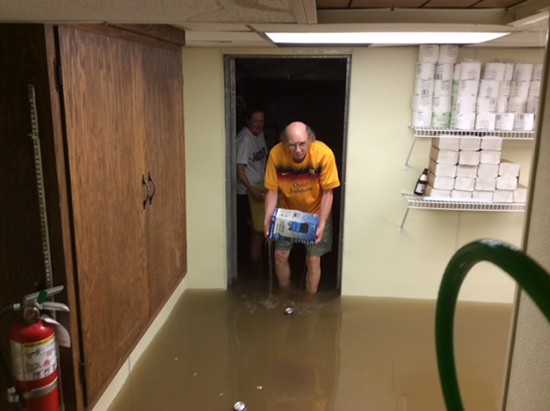
Sep.19, 2018 – Just hours away from his official retirement, longtime Reedsburg attorney Myron LaRowe found himself sleeping on his law office floor, his presence the only security available to protect the firm’s files and assets amidst the flooding.
Heavy and sustained rains in late August caused the Baraboo River to overflow onto Reedsburg’s Main Street, the location of La Rowe’s small law firm, La Rowe, Gerlach Taggart LLP. La Rowe, a former president of the State Bar of Wisconsin (1981-82), checked on the law office in the evening to find a foot of water in the firm’s basement.
“It was the 100-year storm, 10 years later,” said La Rowe, noting the law office experienced similar flooding in 2008, when the Baraboo River spilled over.
They ran sump pumps out the firm’s back door, which had to remain open through the night, until the flooded basement was bailed. Hence, La Rowe stood guard, just as he did 10 years earlier, hoping the sump pumps would not fail to clear the water.
“We had not stored any files down there,” LaRowe said. “That was the lesson we learned from 2008. But you really have to be prepared for the unexpected.”
As the river swelled, the firm’s lawyers took action, removing assets from areas where flooding might reach them. Similar to 2008, only the basement flooded, but sustained rains could have threatened computer and other equipment on the main floor.
LaRowe said the firm’s lawyers and assistants showed up to wade through the mess, including Joseph Hasler, who doubles as chair of the Madison College District Board.
Like La Rowe, many lawyers were likely impacted in one way or another as the entire state was in a declared flood emergency. Events like this provide a good opportunity to remind lawyers and firms that disaster planning is a crucial component of any practice.

Joseph Hasler, an attorney with La Rowe, Gerlach Taggart LLP, carries items out of the law firm in Reedburg, following the flooding that occurred in August of 2018.
No Time Like the Present
Fortunately, Wisconsin doesn’t need to deal with hurricane season, like the Carolinas are dealing with now. But Wisconsin has its own weather challenges from time to time. As LaRowe mentioned, the flooding of 2008 was devastating for 31 counties.
 Joe Forward, Saint Louis Univ. School of Law 2010, is a legal writer for the State Bar of Wisconsin, Madison. He can be reached by email or by phone at (608) 250-6161.
Joe Forward, Saint Louis Univ. School of Law 2010, is a legal writer for the State Bar of Wisconsin, Madison. He can be reached by email or by phone at (608) 250-6161.
 Christopher C. Shattuck, Univ. of La Verne College of Law 2009, M.B.A. U.W.-Oshkosh 2015, is manager of Practice411™, the State Bar’s law practice assistance program. If you have questions about the business aspects of your practice, call (800) 957-4670.
Christopher C. Shattuck, Univ. of La Verne College of Law 2009, M.B.A. U.W.-Oshkosh 2015, is manager of Practice411™, the State Bar’s law practice assistance program. If you have questions about the business aspects of your practice, call (800) 957-4670.
But major flooding is just one type of disaster to think about. In 2010, tornadoes threatened law practices in Eagle. In 2012, attorney Tom Watson wrote about an office building fire that impacted a dozen law firms and caused $2 million in damage.
“Those lawyers are probably like the rest of us. The possibility of such a devastating event happening to their offices was most likely the last thing on their minds,” Watson wrote in his Wisconsin Lawyer article, “Prepare a Disaster Recovery Plan Before Disaster Strikes.” Watson notes that such events severely disrupt business, in addition to the emotional trauma, and a disaster plan helps mitigate the disruption.
“Planning now can save you, if a disaster does occur, from interrupted client services, missed deadlines, and lengthy office downtime. All of those can result in losing clients and money or even being the target of a malpractice claim,” Watson wrote.
Create, Review, Test
Business continuity and disaster planning are important and distinct plans that should be part of every firm’s emergency protocol.
Business continuity focuses on continuing operations after a triggering event occurs, and disaster planning focuses on the ability to restore the necessary hardware and applications that are needed to run your firm after a triggering event occurs. If your firm is putting together a disaster plan, the following steps should be included in your plan.
1. Create a disaster recovery plan. This process involves identifying the hardware and applications your firm needs to operate a law office. The Bar Association of Erie County, New York, developed a sample disaster recovery plan the can help lawyers get started.
There are also free sample plans that can be downloaded from Ready.Gov – IT Disaster Recovery Plan and SearchDisasterRecovery.com.
More and more law firms run paperless operations, or have started to move in that direction. One of the most important aspects of a disaster plan involves backing up data and storing it offsite, so your files can be recovered in the event of data loss.
2. Review the disaster recovery plan. After you have created your plan, have trusted staff and vendors review the plan to ensure that you have covered all your bases. The information contained in the plan may contain sensitive and confidential information regarding the firm’s infrastructure, so you should share the document only with trusted staff and vendors.
3. Test the disaster recovery plan. One way to ensure all applications and hardware are covered in a disaster recovery plan is to test the plan. This can be accomplished by simulating a hardware or application failure and then testing your backup plans.
It’s also recommended that lawyers prepare a brief report regarding the test and identify the strengths, weaknesses, opportunities, and threats (SWOT) from the test.
4. Review and revise the disaster recovery plan. After the disaster recovery plan and report have been completed, go back to the original plan and make the appropriate revisions. Perhaps a hardware or application took too long to restore, and you consider an upgrade to reduce the restore time. Other efficiencies will be identified throughout this process and should be captured in the modified plan.
5. Test and revise the disaster recovery plan annually. Any changes to your software or hardware should be reflected contemporaneously in your disaster recovery plan. Testing and revising the plan should occur at least once a year to ensure that you have accurate information and processes in place to address a disaster. Creating a plan once, and then never testing it again, is almost as bad as not having any plan at all.
If you would like more information on this topic, safeguarding the client file, business continuity, and disaster planning, contact the State Bar of Wisconsin Practice 411™ Program by phone (800) 957-4670, or by email, at practicehelp@wisbar.org.
